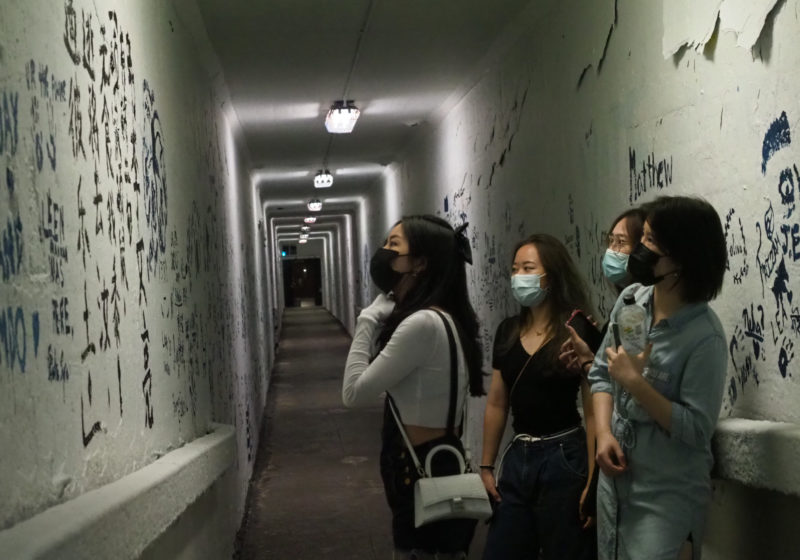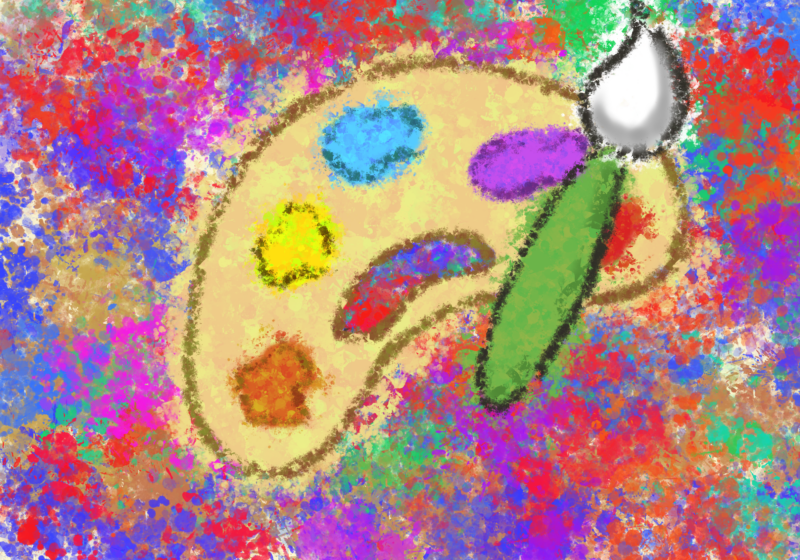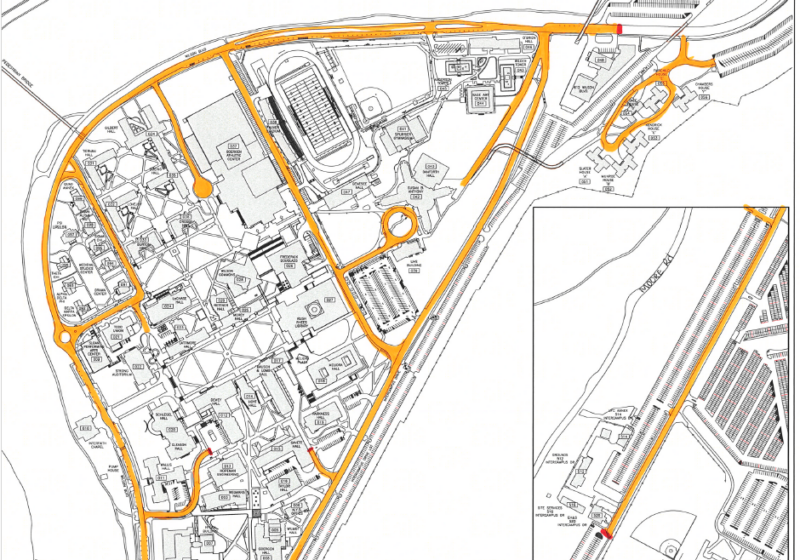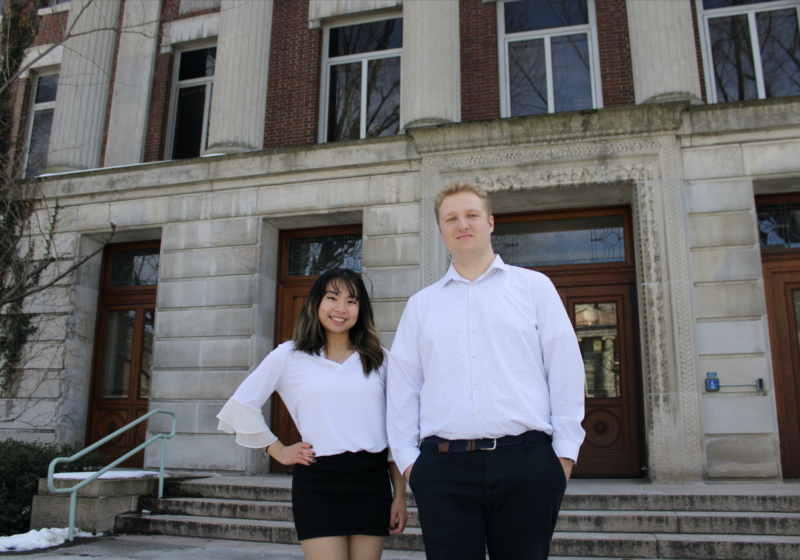The iconic stretch of tunnel underneath Eastman Quad used to constantly change, with new colors and messages from students, for students. But for the past year, the tunnels have been brought to a standstill, the walls sitting in their old paint jobs for over a year, adorned with mostly political messages. The tunnels have not seen a fresh coat of paint since last week, as COVID-19 safety guidelines banned tunnel painting for the 2020-2021 school year. Although tunnel painting remains banned at the time of publication, it is anticipated that painting will be re-approved in the coming weeks.
Even with this blip, the tunnels are still a visual representation of the student body and campus culture. They are where the UR community comes together to express themselves, and serve as brief documentation of campus events.
The idea for the entire tunnel network started in the 1920s, exclusively for Strong Medical Center. In the ’30s the tunnels crept into River Campus, sprawling out from Rush Rhees and Wilson Quad, a reprieve from Rochester’s harsh winter winds. Much of the original network is inaccessible to the public today, as the needs of the college community changed. For example, the tunnel leading from Susan B. Anthony Hall to Rush Rhees was closed in an effort to make the dorm more secure. The tunnels connecting River Campus and the Medical Center were also closed to the public.
Color seemed to have entered the picture in the late 1960s in two places: the tunnel connecting Hoyt Hall to Eastman Quad (the tunnel we still paint today), and the now-closed tunnel to the Medical Center. The paintings were a loose collection of the collegiate mindstate. Political phrases, Greek life letters, random names, and inventive innuendos filled the walls, such as: “Candy is dandy but sex don’t rot your teeth,” “The dollar standard will not last,” and “This is a good tunnel, but not a great one.”
In a more organized effort to spruce up the walls, Residential Life commissioned a series of paintings in 1983 in the tunnels connecting all of the Hill Court dorms to each other. The paintings were done to cover up graffiti and bring life into the drab tunnels. Residential Life was concerned at the time that the graffiti would return and ruin their hard work, but over 20 years later the artwork has remained relatively intact.
Under Susan B. Anthony Hall, a cacophony of paintings and spray-painting sits, reminiscent of the lawless creativity of the Hoyt-Eastman tunnel in the ’60s. This short tunnel leading to Spurrier is now the only one of its kind, now govern the only other space that encourages painting, Hoyt-Eastman.
By the early 1990s, the Hoyt-Eastman tunnel had become overwhelmingly a place for UR organizations to advertise their events. The unwritten rules are pretty simple: Don’t paint over another group’s advertisement until their event has already happened. Although logical, these rules were a bit hard to enforce, as a complaint from the swim team in a 1994 Campus Times issue shows. The Swim team’s promotion for their championship was overtaken by the Peer Health Group’s “Condom Week” advertising before the championship had taken place.
“If their issue was important enough to paint the tunnel, then it should have been important enough to do a good job,” the swim team stated. “We hope that in the future, groups who decide to paint the tunnel will take into consideration the hard work and effort put forth by the previous painters.”
A similar complaint surfaced in 2012, when UR Cinema Group published an op-ed in CT complaining that several someones had painted over their advertisements for their Oscar Party and spring porn showing, even though neither had happened yet.
More serious offenses have also taken place in the tunnels pretty routinely. In spring 2001, UR sorority paintings were targeted and vandalized with sexual, racial, and hurtful comments. Throughout the semester, there were uncharacteristic appearances of racial and hompohbic slurs in the tunnels. These were quickly painted over, and UR Vice President and Dean of Students Paul Burgett responded to the vandalism.
“Every few years, it seems somebody does something thoughtless and insensitive that triggers a series of copycat-like reactions,” he said in a statement. “While it is troublesome […] such behavior has not been so prolific or destructive to suggest that we should eliminate tunnel painting. I would not want to punish the entire student tunnel-painting community because of the actions of a few.”
In 2008, the PRIDE Network’s artpromoting “Gaypril” was misidentified by administration as vandalism, and almost entirely painted over. Facilities covered up language deemed inappropriate, such as “fags have more fun” and “suck d*** all day,” which they said they thought was vandalism over the PRIDE Network’s original message. However, facilities also covered up useful information such as times and places for the organization’s events. The PRIDE Network stated that any references to homosexuality were covered up, inlcuding educational ones.
In 2009, Students for a Democratic Society (SDS) organized a protest in response to the Gaza War. The goal of the protest according to SDS leaders was to influence UR to reevaluate their funding to avoid supporting the war, through actions like adopting a Peaceful Investing Initiative that would divest from corporations involved in manufacturing weapons. In addition to a planned sit-in, pro-Gaza messages appeared in the Hoyt tunnel, but were covered up after the protests.
When the Chinese Students Association painted in the tunnels to advertise their China Nite event in 2010, their posters were torn down and a six-foot spray-painted “Free Tibet” appeared over CSA’s painting. Administration responded by having facilities covering up the painting.
More recently, in fall 2019, a group of students painted messages supporting democracy in Hong Kong, autonomy for Tibet and Taiwan, and protesting human rights violations against Uighurs. These paintings sparked a series of reactions in the tunnels, where the original paintings were quickly covered up with seemingly apolitical censorship by other UR students. This started a back-and-forth between students, gained local and international attention from media outlets, and had a major hand in the removal of the iconic flag display in Hirst Lounge.
As the surrounding advertisements became outdated, political messages for social justice and human rights began replacing them. These remained on the walls through the winter, and through March 2020, when most students were asked to leave campus in response to COVID-19 and painting was initially banned. Most of the paintings from the 2019 paint-war stayed on the walls until mid-August, when the tunnel was routinely painted in anticipation of a first-year orientation activity.
For better or for worse, the paintings in the tunnels are a representation of the UR student collective. They serve as a source of excitement for upcoming events, and a way to promote the hard work of student organizations. The paintings advocate for some members of the community, but they also show the less accepting feelings of other members. The tunnels show how we as a university handle adversity. The tunnels show how we come together to discuss, educate, and grow — which is arguably the foundation of a collegiate experience.
As a UR student once wrote, “these are good tunnels, but not great ones,” suggesting the need for continued growth.






